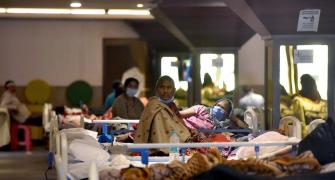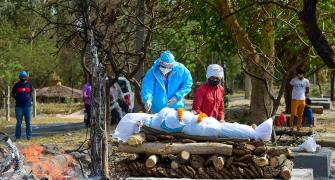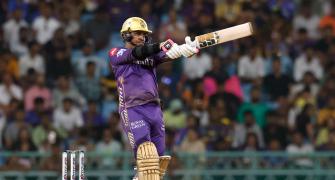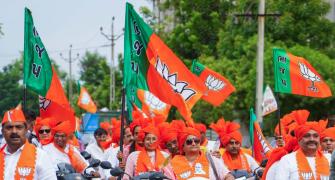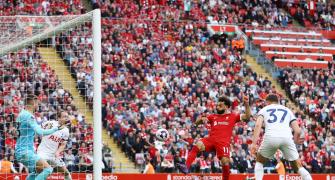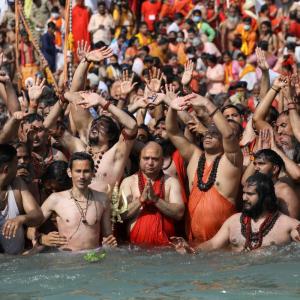'From April 25, 2021, Modi disappeared. He made no public appearance for 20 days.'
'The prime minister of India fled the field when his people needed the government most,' points out Aakar Patel.

Three years ago, on April 15, 2021, the National Taskforce on Covid met for the first time in three months (the last meeting was on January 11, 2021).
Cases were now at 216,000 and deaths over 1,100. Two days after that, April 17, Narendra Modi held what he said was his largest-ever rally in Asansol, with lakhs of people in audience.
Daily positive cases that day were 260,000 with 1,500 deaths.
Till this time, Modi appeared to be oblivious to the power of exponential growth though the government was warned specifically and severally about an impending second wave.
It was only after he returned that evening from Bengal and perhaps internalised the commentary on television of the devastation in Delhi's hospitals that Modi acted.
The next day, April 18, Modi cancelled further activity at the Kumbh.
Daily cases were now at 275,000 but it still took another four days for Modi to cancel his rallies in Malda, Murshidabad, Birbhum and Kolkata.
He said the rallies would be 'virtual' (in reality, only the speaker was virtual and appeared on a screen; the crowd still gathered).
By now, cases were at 332,000 with 2,200 deaths daily. The same day that Modi cancelled his rallies, the obliging Election Commission banned rallies for all parties.
In guiding India through this second wave, Modi flew by the seat of his pants.
Structurally, there was nothing other than his office running the Covid strategy.
The Union Cabinet did not decide or discuss a single issue related to the pandemic as the second wave surged through March and April 2021.
It met five times, but only to clear things like the second phase of Bangalore's metro project and some memoranda of understanding with foreign nations.
Even on May 11, it met only to approve things like a ropeway project in Uttarakhand.
Ministers did not appear to know what Modi's vaccination strategy was, or if indeed he had any.
On May 18, Nitin Gadkari asked for more firms to be issued the licence to make the vaccine.
This was reported the next day, and it was pointed out that this was exactly what Dr Manmohan Singh had suggested to Modi a month before (a suggestion that was met with an insolent reply from Harsh Vardhan).
In the face of calamity, Modi froze. In the seven months from March to September 2020, Modi made 82 public appearances -- physical as well as virtual. In the next four months, he made 111 such appearances.
From February to April 25, 2021, he clocked 92 public appearances.
From April 25, after he called off the Kumbh and his Bengal rallies, Modi disappeared.
He made no public appearance for 20 days. The prime minister of India fled the field when his people needed the government most.
Twice in 2020, in April and in November, the government had been warned that an oxygen shortage was looming.
The minutes of one meeting said in clear terms: 'In the coming days India could face a shortage of oxygen supplies.'
While before April Modi did not himself take the pandemic seriously, he also insisted on managing it personally.
If there was any strategy at all in tackling the pandemic, it came directly from Modi's office; there was 'no role for the Cabinet in pandemic control, PMO calls the shots', as an Indian Express headline put it.
This was in keeping with the way in which he has run the government all this time.
A wave that began at the end of February was not only allowed to gather momentum, it was goaded on.
Through four weeks of March, through three weeks of April, India held gigantic gatherings directly organised by the BJP or approved and encouraged by it.
The consequences were felt by the country's healthcare system, which was always fragile and unavailable to the poor at the best of times.
Here, the second aspect to tackling a pandemic, the failure to anticipate the effects of a sudden wave and the preparation of a warchest of medical equipment, came into play.
In the eight weeks between March 1 and April 30, India's daily cases grew 40 times from 11,000 to more than 400,000.
No healthcare system in the world can handle an explosion of patients of this sort.
The only way to protect the population is to stockpile things that may not be immediately required today but are produced and procured and set aside in anticipation of a wave's peak.
India did not do that.
In April 2020, the government decided it would procure 50,000 'Make in India' ventilators, but ultimately only procured 35,000 of them after it determined that the pandemic had been seen off.
Corporates like Maruti said they had made ventilators, but the government chose not to procure them.
Two months before the second wave, on February 21, 2021, the BJP passed a resolution: 'It can be said with pride that India not only defeated Covid under the able, sensitive, committed and visionary leadership of Prime Minister Shri Narendra Modi, but also infused in all its citizens the confidence to build an "Atmanirbhar Bharat'.
'The party unequivocally hails its leadership for introducing India to the world as a proud and victorious nation in the fight against Covid.'
When the crematoria began to overflow, no reference was this to made.
All this may not affect the claims and the bombast, but this is not history from 1526, this happened to us three years ago and must not be forgotten.
Aakar Patel is a columnist and writer and you can read Aakar's earlier columns here.
Feature Presentation: Aslam Hunani/Rediff.com


